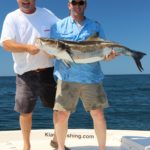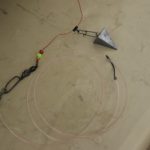
Understand that cobia are almost never shy about anything, and you’ll be on your way to a great spring season fishing in St. Helena Sound.
It’s cobia season, and while this year’s will be a shortened version thanks to new federal regulations, plenty of anglers will be lining up in St. Helena Sound fishing for “the man in the brown suit.”
It’s as good a place as any along the South Carolina coast to catch one of these unique fish. Buddy Bizzell of Edisto Palmetto Charters catches cobia here every year, and he’s got some off-the-wall ways of doing it.
“When people see me on the water, they don’t have to look very hard to realize it’s me. They can spot me from a mile away,” Bizzell said.
One reason is that, tied to Bizzell’s anchor rope is a big, inflatable sea turtle. The floating turtle seems to draw the cobia in.
“This time of year, you’ll notice a lot of big sea turtles in the sound. When you see one of them, you can bet some cobia are around. Cobia are very curious fish, and they’ll just swim up to something on the surface to check it out,” he said.
Another thing Bizzell does attracts cobia and helps other fishermen recognize him. He likes to throw out bread, crackers and stale cereal to attract birds. He’ll often have a sky full of diving birds just behind his boat.
“When you get the birds working, the cobia will see them and come to them. Keeping birds working on the surface above where your baits are will help you catch more cobia,” he said. “It’s better if the birds are working actual baitfish, but when none are there, you can create your own frenzy from the birds, and the cobia will notice.”
When it comes to equipment, Bizzell doesn’t go light. He uses an 8/0 hook and a 3-foot section of 80-pound leader, a heavy duty swivel and a pyramid sinker that ranges anywhere from 2 to 6 ounces. He will change the size of his sinkers throughout the day as the current lessens or weakens with the tide.
Bizzell relies on 7- and 8-foot, medium-heavy Ugly Stik Tiger rods and 4500 to 6500 series spinning reels or 30- and 40-wide level-wind reels.
Bizzell uses a variety of cut and live baits to entice cobia to bite. He said they are not particularly picky eaters, and their curious nature will lead to them to investigate just about anything of any size. Using a larger bait helps in other ways, too.
“Using bigger baits is a big help in keeping small fish from irritating you too much,” Bizzell said. “A variety of small fish live in the sound, and they’ll hit everything, as long as it isn’t bigger than they are. Using large, live baits or large chunks of cut bait will ensure that your bait will have a better chance at luring a cobia into biting rather than having a black sea bass, croaker, whiting or any other smaller fish to pick at it.
Even more important than the size of your baits is making sure they are fresh. While cobia aren’t picky about what they eat, they do prefer it to be fresh. They also prefer eating baits that are easy on their soft mouths.
“I like to fillet baitfish and put just the meat on the hook — no bones, so scales. They are a soft-mouthed fish, and more often than not, they’ll drop a bait if it’s bony,” Bizzell said. “They also want it to be fresh. I check my bait every 10 minutes. If it’s lost its color and turned white, you’ll catch plenty of sharks and rays, but cobia will rarely mess with them once they lose their color and smell.”
In May, Bizzell said anglers should expect to see a number of cobia hanging around the boat at any given time. They shouldn’t get discouraged if these fish don’t bite right away. He said the biggest mistake he ever made was leaving a group of cobia that weren’t biting to try and find a group that would bite. He didn’t catch a cobia that day, but he saw another boater catch one in the spot he had been in earlier.
“I had a group of several cobia all around me. We threw baits, big lures, did everything we could to pester them into biting. They never left,” he said. “They stayed, and we left. That was a big mistake. I knew the fish were there; they were not swimming off, and I should have just waited them out. They obviously bit, because another guy who anchored down right where we were caught one not long after we pulled anchor and began trolling around looking for another spot to fish,” he said.
“A lot of times, cobia will come up from the bottom and just hang out behind the boat. Sometimes they’ll swim in a circle around it, and sometimes they’ll swim back and forth along the side of it. And when you throw a lure or bait straight at them, they’ll often swim right up to it as if they’re going to bite but don’t,” said Bizzell.
Patience, Bizzell said, is the key here.
“You might have five or six cobia just hanging out around your boat like that for an hour — even longer than that sometimes. They might disappear, then reappear. What they are doing is just swimming to the bottom, then coming straight up, checking things out, then swimming back down. When that many are hanging around you, the best thing to do is hang tight, make sure you have plenty of baits at different parts of the water column. At some point, they will get hungry and bite,” he said.
Bizzell can usually gauge when the bite will start when cobia are hanging around like that.
“When the tide changes from slack to incoming, or from slack to outgoing, there is about a 45-minute period when these fish will usually eat. If you can keep them interested enough to stay around until that tide change, you’ll be in business,” he said.
Cut menhaden is one of Bizzell’s favorite baits, and while most of his cobia have come from rigs on the bottom, he’s caught enough near the surface that he always has one or two baits close to the surface. He usually suspends these with a balloon or a big float.
Finding the right place to fish in St. Helena Sound is simple, according to Bizzell.
“There’s an easy-to-see line that runs through the sound — where clean water meets dirty water,” he said. “You want to anchor near that line, but in the clear water enough so your baits are in clear water but close to the line. Cobia love to hang out near that line. That line will move throughout the day as the tide rolls in or out. You want to keep your boat in the clear water. If you get overtaken by the dirty water, just pull your anchor and move to about 50 feet into the clear water, and anchor down again.
DESTINATION INFORMATION
HOW TO GET THERE — St. Helena Sound is most-easily accessible from boat ramps in the Edisto area. SC-174 gives easy access to Edisto once in the general vicinity. US-17 provides easy access from the area to the north and south. A combination of I-77, I-26, and I-95 will put most anglers from the Upstate and Midlands on the right track.
WHEN TO GO — The first cobia begin showing up in the sound in late April, and the run can continue through May and occasionally into June. Cobia season ends this year on June 20.
BEST TECHNIQUES — Cobia are curious fish and not particularly picky about what they eat. Eels, crabs, live or cut menhaden and other fish are always good bets. Most cobia are caught on the bottom, so Carolina rigs with sliding pyramid sinkers, size 8/0 hooks, medium-heavy to heavy rods and 80-pound line are standard. Chumming works well. Big lures can be cast under and around buoys and schools of menhaden for anglers looking for cobia offshore.
FISHING INFO/GUIDES — Buddy Bizzell, Edisto Palmetto Charters, 803-603-2781; Capt. Rob Bennett, Lowcountry Inshore Charters, 843-367-3777, www.kiawahfishing.com; Capt. Jimmy Skinner, Fontaine Charters, 843-270-8087, www.fontainecharters.com.
ACCOMMODATIONS — Wyndham Ocean Ridge, Edisto Island, 843-869-5154; Edisto Rental Realty, Edisto Island, 866-856-6538; Atwood Rentals, Edisto Island, 866-713-5214.
MAPS — Capt. Segull’s Nautical Charts, 888-473-4855, www.captainsegullcharts.com; DeLorme’s S.C. Atlas and Gazetteer, 800-561-5105, www.delorme.com; Navionics Maps, 508-291-6000, www.navionics.com.







Be the first to comment